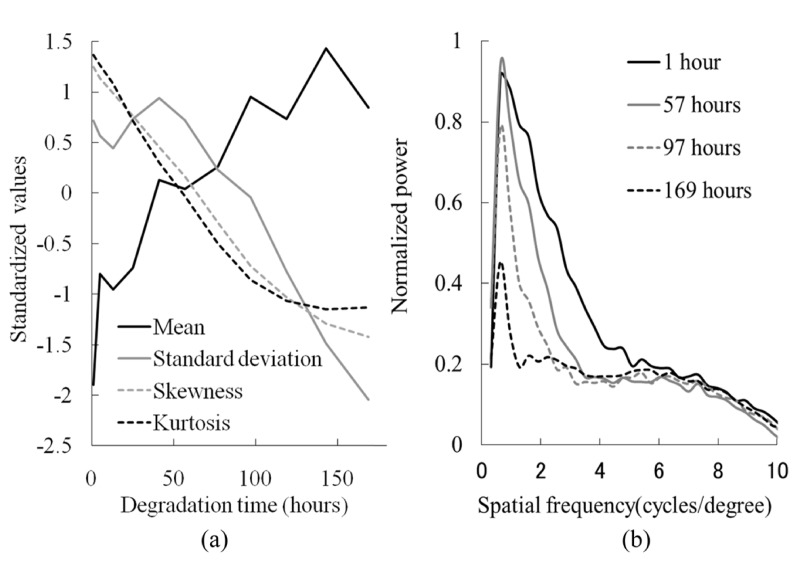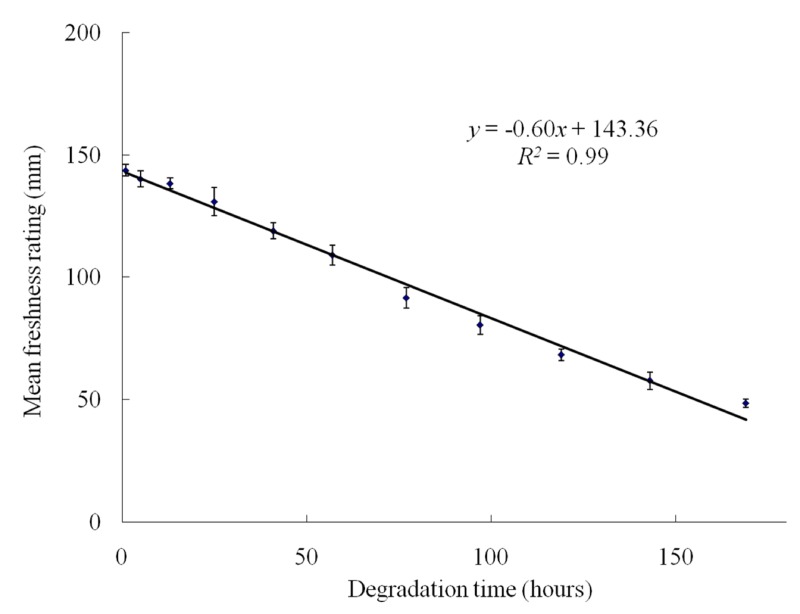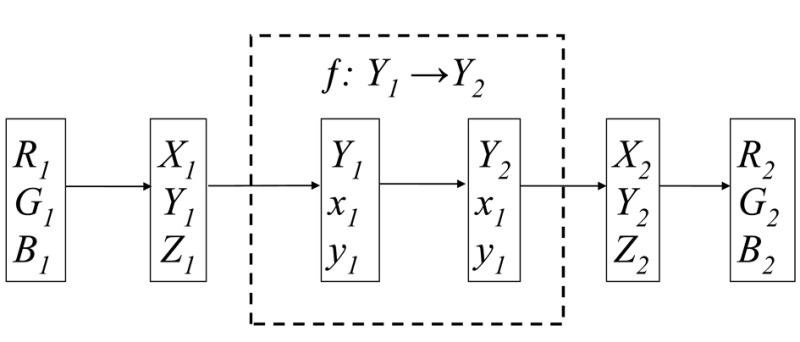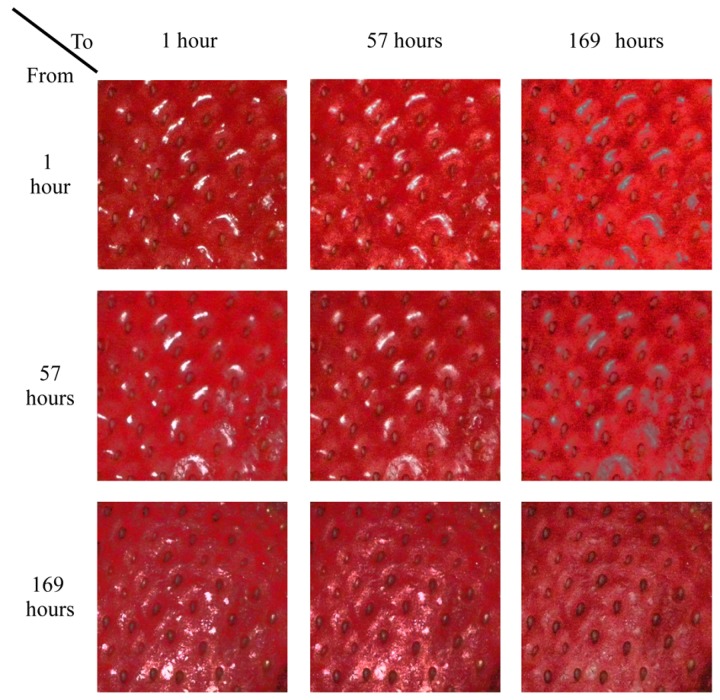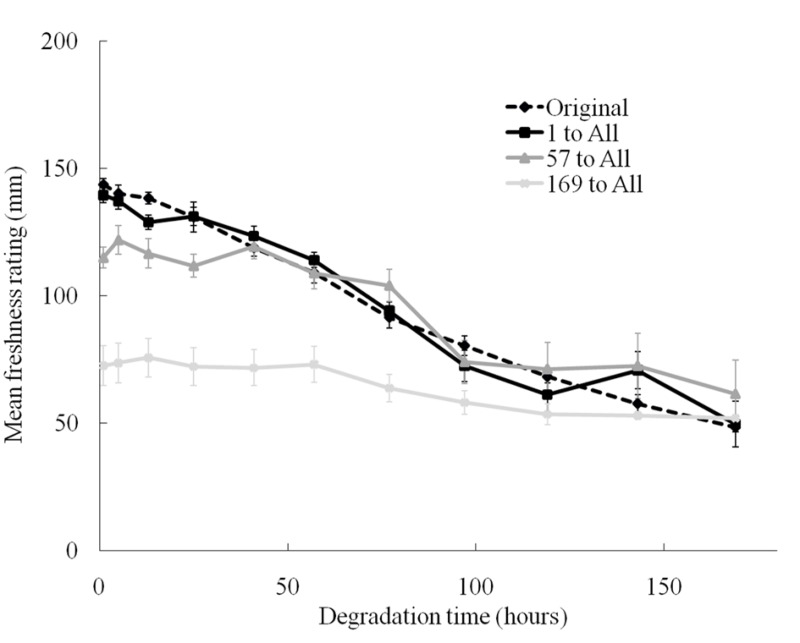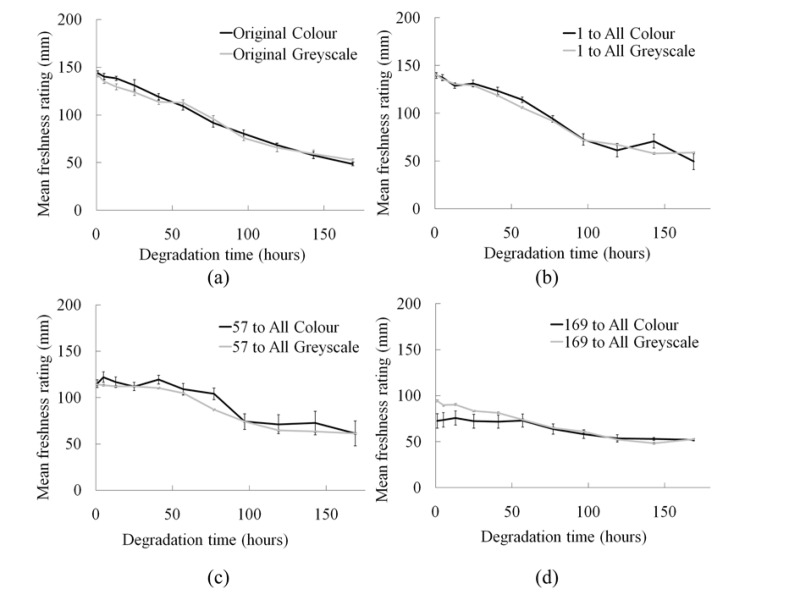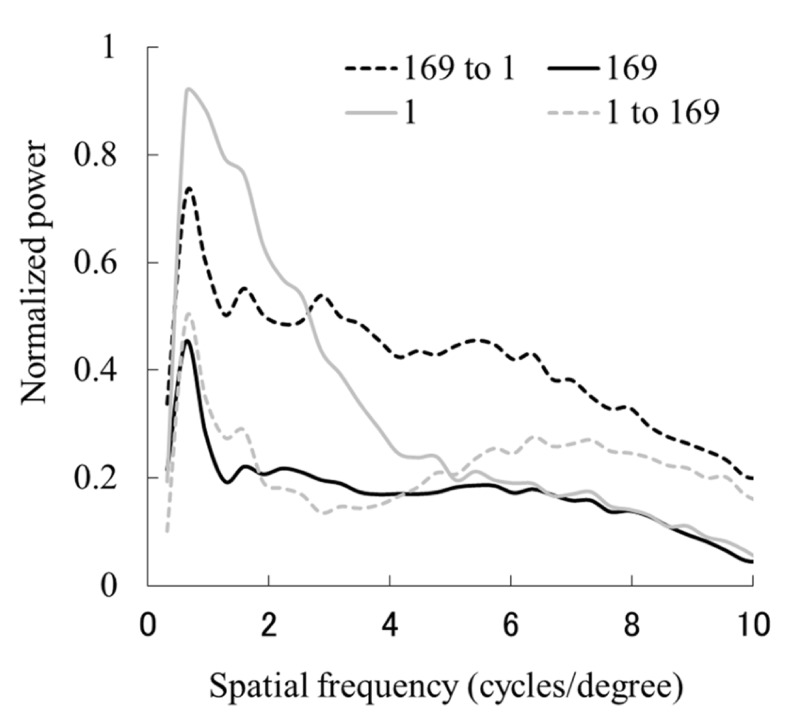Abstract
Material perception studies focus on the analysis of visual cues that may underlie the ability to distinguish between the different properties of an object. Herein, we investigated the effects of luminance distribution on the perceived freshness of a strawberry independent from its colour information. We took photographs of the degradation of a strawberry over 169 hours in a controlled environment, then presented cropped square patches of the original images to subjects who then rated the perceived freshness using a visual analogue scale. Freshness ratings were significantly highly correlated with statistical measures of the luminance and colour channels. To clarify which of these visual cues affects freshness perception, we created artificial images by modifying only the luminance distribution and keeping the colour information unchanged. The modification of luminance resulted in a highly correlated change in freshness perception, suggesting that luminance visual cues are essential to the freshness perception of strawberries. Finally, by eliminating the colour information from the images, we examined the contribution of luminance distribution independent of colour information and found that luminance information suffices for accurate estimation of strawberry freshness.
Keywords: Visual freshness perception, luminance distribution, image analysis, statistics, band-pass filter, strawberry
1. Introduction
When we make quality discrimination decisions in daily life, we rely considerably on visual cues. For example, when estimating the quality of food products in a market, visual information contributes to the consumer's choice. In food science, previous research has emphasised the importance of investigating quality properties that influence human judgment. Indeed, the outcome of several daily tasks depends on the ability to perceive product quality. Moreover, several studies on consumer behaviour have clearly shown that various aspects of food appearance, such as colour, shape, and display, affect various aspects of human eating behaviour (Dunker 1939; Kanig 1955; Richardson-Harman and Booth 2006; Rolls et al 1982; Wada et al 2007; Zellner and Kautz 1990). A study on the sensory attributes influencing consumer perception of the freshness of strawberries and carrots (Peneau et al 2007) reported that subjective visual parameters such as bruises and shininess were the best predictors of such perception. However, attempts at relating complex assessments such as freshness perception with shininess or bruise perception have not revealed any relationships with the image features responsible for these perceptions. For example, the optical and physical properties that serve as cues to shininess (or glossiness) perception are only now beginning to be understood. The perception of surface reflectance is not a trivial ability, as it depends on properties of the light field (Fleming et al 2003; Doerschner et al 2010; Olkkonen and Brainard 2010) and of the stimulus presentation (Wendt et al 2010). Moreover, glossiness perception involves a complex and intricate analysis of spatial consistency between the specular highlights and surface geometry of an image (Kim and Anderson 2010).
In the field of vision science, material perception studies focus on the analysis of visual cues that may underlie our ability to discriminate between different properties of an object. For example, material perception has been studied for handmade stucco surfaces (Motoyoshi et al 2007), Lambertian surfaces (Wijntjes and Pont 2010), and even 3-D mesotextured surfaces (Ho et al 2008). However, studies must be undertaken with stimuli related to daily tasks in order to avoid results that are valid only in laboratory environments. In fact, higher-order cognitive assessments such as freshness perception of vegetables or age perception of the human skin (Arce-Lopera et al 2009) need naturalistic stimuli. Recently, material perception studies have started to undertake complex assessments, such as the perception of material changes (Yoonessi and Zaidi 2010) or of decay of natural objects (Wada et al 2010), using naturalistic rather than real stimuli. Despite the inevitable shortcomings that result from limited control over the stimuli and experimental conditions, the compromise between using realistic stimuli instead of real stimuli is an interesting and practical approach to revealing the underlying processes involved in complex quality assessments. For example, a recent study aimed at understanding the relationship between luminance distribution and complex quality judgments such as food freshness revealed that freshness perception of a cabbage leaf was significantly highly correlated with statistics of its luminance channel (Wada et al 2010). The objective of the present study was to investigate which image properties are responsible for the freshness perception of another vegetable texture using a refined experimental procedure. Here, we analysed the degradation process of a strawberry over 169 hours in a light-, humidity-, and temperature-controlled environment. The strawberry Fragaria x ananassa Duch. is known for its attractive appearance, unique flavour, and nutritional content (Hancock 1999). Its widespread popularity as a fresh table fruit, its high sensibility to degradation, and its characteristic textural cues were the three main reasons why we selected this strawberry for our stimulus images. Despite using only one type of stimulus fruit (the strawberry) here, we believe that the results can likely be extrapolated to other types of vegetables with similar visual ageing properties, such as carrots and cabbages. First, we designed Experiment 1 to determine which image attributes were plausible candidates for a freshness estimator. Then, Experiment 2 tested the involvement of several visual cues in the freshness perception by using artificial stimuli for which only the luminance distribution was modified. In Experiment 3, we transformed the visual stimuli into greyscale to eliminate all colour information, in order to examine the influence of the luminance distribution on perceived freshness.
2. Experiment 1: Freshness estimation
We designed this experiment to determine which visual cues can be used to estimate freshness.
2.1. Methods
2.1.1. Subjects
Ten subjects, 23 to 41 years of age, took part in the experiment. All had normal colour vision and normal or corrected–to-normal visual acuity. None had specialist knowledge in cooking, trading, or farming vegetables. Each participant provided written consent according to the guidelines specified by the ethics committee of the National Food Research Institute, and experiments in this study were carried out in accordance with the relevant institutional and national regulations and legislation, and with the World Medical Association's Helsinki Declaration as revised in October 2008 (http://www.wma.net/en/30publications/10policies/b3/index.html).
2.1.2. Apparatus
We presented the visual stimuli on a 22-inch CRT monitor (Iiyama HM204DA) using ViSaGe (Cambridge Research Systems Co. Ltd.). A colorCAL colorimeter (Cambridge Research Systems Co. Ltd.) was used for display calibration. To prevent any surrounding light from interfering with the stimuli, the experiment was conducted in a dark room. The observer's head was fixed on a chinrest. The viewing distance between the display and the chinrest was about 57 cm. To avoid any artefact introduction when changing the size of the stimuli, the original resolution (512×512 pixels) of the image was kept, making the size of the stimuli 15.7 ×15.7 degrees of visual angle. Additionally, preliminary experiments revealed that there were no significant differences between using these settings and using stimuli half the size, which corresponded to seeing the real strawberry at a distance of approximately 20 cm.
2.1.3. Stimuli
In a dark room, we kept humidity and temperature at 6% and 30°C, respectively, and took photographs of the degradation process of a strawberry using the automatic timer of a camera that took one picture each hour for 169 hours. We fixed a digital camera (Nikon COOLPIX P5100) on a tripod inside a box designed for taking photographs (D' CUBE J3 116×100×100 cm). Illumination was achieved using two floor lamps with a colour temperature of 5400 K. As stimuli, we used patches of 512×512 pixels of the pictures taken at 1, 5, 13, 25, 41, 57, 77, 97, 119, 143, and 169 hours of the freshness degradation process. We cropped all images at the same approximate coordinates (Figure 1). Square patches were selected to remove information about the shape of the object. Therefore, subjects were limited to viewing the luminance, colour, and textural cues. Also, objects with characteristic visual texture, such as the strawberry, are easier to identify even without colour information or when reduced to cropped patches (Yoonessi and Zaidi 2010).
Figure 1.
Examples of the 512×512 pixel patches selected as original stimuli. The number above each stimulus is the time when the photograph was taken.
A standardized plot of the luminance statistics for all stimuli (Figure 2a) reveals the modification of all statistical values as a function of the degradation process of the strawberry. Standardization scales the data using the following equation:
where Z is the standardized value, X is the real value, μ is the mean of the distribution, and σ is the standard deviation of the distribution. In addition, for several stimuli, a clear difference in power magnitude can be seen for bands between 1 and 5 cycles per degree (Figure 2b).
Figure 2.
Luminance statistics, power spectrum, and degradation time of the stimuli. (a) Standardized luminance statistics as a function of degradation time. Black, dark grey, medium grey, and light grey lines correspond to the mean luminance, luminance standard deviation, luminance skewness, and luminance kurtosis, respectively. (b) Normalized luminance power spectrum as a function of frequency and degradation time. Black, dark grey, medium grey, and light grey lines correspond to the normalized luminance power spectrum of the image patches at 1, 57, 97, and 169 hours, respectively.
CIE76 colour differences (Δ∗Eab) between the image at 1 hour and those at the other time points (Table 1) show that, similarly to the luminance features, colour information of the stimuli changed in accordance with degradation time. The colour difference averaged 7.9, with a standard deviation of 4.8; both values are above 2.3, which corresponds approximately to a just-noticeable colour difference (Sharma 2003). In summary, for the stimuli selected, the luminance statistics, luminance spatial information, and colour information changed according to degradation time. We hypothesised that presenting these stimuli would result in a perception of decreasing freshness.
Table 1. Mean colour of the original images and colour differences (Δ∗Eab) between the image at 1 hour and the images at other time points.
| Time (h) | 1 | 5 | 13 | 25 | 41 | 57 | 77 | 97 | 119 | 143 | 169 |
|---|---|---|---|---|---|---|---|---|---|---|---|
| L∗ | 52.1 | 53.4 | 53.2 | 53.4 | 54.4 | 54.3 | 54.6 | 55.41 | 55.16 | 55.93 | 55.29 |
| a∗ | 46.0 | 46.2 | 46.4 | 46.1 | 45.4 | 45.4 | 44.3 | 42.92 | 41.45 | 38.85 | 37.24 |
| b∗ | 6.4 | 2.9 | 2.1 | 2.1 | −0.1 | −0.2 | −0.9 | −2.38 | −3.54 | −5.95 | −6.48 |
| Δ∗Eab | 0.0 | 3.7 | 4.5 | 4.5 | 6.9 | 7.1 | 7.9 | 9.94 | 11.41 | 14.83 | 15.96 |
2.1.4. Procedure
Subjects binocularly observed the presented stimuli in a dark room after a dark adaptation period of 10 minutes. At the beginning of the experiment, we presented two reference images on the screen display: the image patch of the strawberry at 1 hour and that at 169 hours of degradation. These images were set as the highest and lowest freshness reference images, respectively. On the visual analogue scale, the highest freshness was set at 150 out of 200, and the lowest freshness was set to 50.
Subjects were able to view the reference images at any time during the experiment just by pressing a button on the computer keyboard. Using the two reference images as anchors in the visual analogue scale has the advantage that the results are directly comparable across participants. However, the inclusion of these two anchors also may lead subjects to judge the test images based on image similarity with the references instead of its freshness perception. To avoid this possibility, before the experiment every participant received a detailed explanation of the experimental procedure emphasising the fact that the visual scale represents the freshness perception of the stimuli and should not be confused with other quality assessments such as image similarity or ripeness perception. The 10-cm visual analogue scale was printed on paper sheets. We asked the subjects to rate the perceived freshness of the strawberry images using this scale for 11 images, at the time points shown in Table 1. These 11 evaluations were repeated 3 times, resulting in a total of 33 trials per participant. In all sessions, the images were presented in random order.
2.2. Results
The freshness experiment resulted in a fit with a high coefficient of determination (R2 = 0.99) for a linear regression with a negative slope (Figure 3). This result reinforces the hypothesis that the stimuli selected represented a constant, gradual decrease in perceived freshness. Thus, only by viewing 512×512 pixel patches of the strawberry, could subjects discriminate freshness. Furthermore, the standard error, represented by the black vertical error bars in Figure 3, was small.
Figure 3.
Results on perceived freshness versus degradation time using the original images. Mean values across the 10 observers and 3 repetitions (N = 30 per data point) are plotted, and the error bars represent standard error values. The black line is a linear regression curve with a coefficient of determination (R2) of 0.99, and with an equation having a negative slope of −0.60 and an intercept with the vertical axis of 143.36.
We calculated the correlation coefficients between perceived freshness and the luminance and colour channel statistics (Table 2). For the luminance statistics and the mean of both colour channels, all correlation coefficients were greater than 0.89 and significant at the 0.01 level (2-tailed). Furthermore, band-pass filtering the luminance channel revealed that the mean magnitude of the power spectrum was significantly highly correlated for frequency bands between 1 and 3 cycles per degree.
Table 2. Pearson correlation coefficients and significance level between specific visual properties and perceived freshness.
| Correlation | p | |
|---|---|---|
| Luminance | ||
| Mean | −0.92 | <0.01 |
| Std. deviation | 0.89 | <0.01 |
| Skewness | 0.99 | <0.01 |
| Kurtosis | 0.98 | <0.01 |
| Colour | ||
| a∗ Mean | 0.94 | <0.01 |
| b∗ Mean | 0.96 | <0.01 |
| Luminance | ||
| Spatial frequency (cpd) | ||
| 0–1 | −0.29 | 0.38 |
| 1–3 | 0.97 | <0.01 |
| 3–5 | 0.57 | 0.06 |
| 5–7 | 0.27 | 0.41 |
| 7–9 | 0.17 | 0.60 |
| 9–11 | 0.03 | 0.93 |
Our hypothesis that presenting the stimuli would result in a perception of decreasing freshness as a function of degradation time was proven to be correct. Furthermore, the freshness perception can be estimated accurately using linear regression and was significantly highly correlated with several properties of the luminance and colour channels. Moreover, the changes in a∗ and b∗ were larger than the changes in L∗ (Table 1), which could indicate a critical role of colour information. Colour vision is believed to have evolved to depict ripe fruits and nutritional leaves (Mollon 1989; Osorio and Vorobyev 1996; Regan et al 2001). Therefore, the mean values of the colour channels should be considered as candidates to be included in a freshness estimator. Additionally, another plausible cue to freshness perception is glossiness (Peneau et al 2007). Motoyoshi et al (2007) related glossiness perception with luminance skewness. However, a significantly high correlation between freshness perception and image statistics does not provide evidence of a causal relationship. Therefore, to test the causal relationship of luminance statistics on the freshness perception of the strawberry independently from colour information, we designed the second experiment.
3. Experiment 2: Freshness manipulation
To investigate the influence of visual information on the perceived freshness of a strawberry, we designed experiments using artificially manipulated images created by modifying only the luminance statistical values and keeping the colour information unchanged.
3.1. Methods
3.1.1. Subjects and procedure
The subjects and procedure were the same as in Experiment 1. The reference stimuli were also identical, with only the test stimuli modified.
3.1.2. Stimuli
We created the artificial stimuli by modifying only the luminance (Y values) of the images and preserving the chromatic information (CIE1931 xy-chromaticity). This technique transforms the RGB values of each pixel into their respective values in Yxy colour space using the calibration data of the display device. Figure 4 shows this colour conversion processing.
Figure 4.
Flow diagram of the colour conversion processing.
To transform the luminance distribution of the visual texture, we chose a histogram matching technique (Horn and Woodham 1979). The dotted rectangle in Figure 4 represents this luminance histogram matching process, which is characterized by the conservation of x1 and y1 (chromatic information) and the modification f of Y (luminance) with respect to the matching technique. The application of the histogram matching technique results in a rough approximation of the statistical measures to a target value. In particular, the result of high-order statistics is dependent of the choice of width of the histogram bin in the image processing algorithm. However, if recursively applied, the approximation to the target ameliorates. Therefore, as an improvement on the original technique, we recursively performed the histogram matching until the algorithm found the closest approximation to the target value. This technique allows a base histogram shape to be matched to a target histogram shape. Moreover, since the algorithm has no consideration for spatial information, the pattern cues present in the base image are preserved. For the matching technique, we selected three images as the base, namely, images at 1 hour, 57 hours, and 169 hours. Then, we matched them to the luminance histogram of all 11 original images, resulting in a total of 33 artificial images. Examples of the resulting stimuli are shown in Figure 5. In the image matrix, columns represent the target luminance histograms while rows represent the base images in the matching algorithm. Therefore, the original images (Experiment 1) are along the diagonal. In Figure 5, the chromatic information, pattern cues and mean luminance stay the same in each row while the high-order luminance statistical values (SD, skewness, and kurtosis) vary from column to column. Similarly, stimuli in one column have similar high-order luminance statistical values while colour information, pattern cues, and mean luminance change from row to row.
Figure 5.
Examples of original and artificial stimuli. Base and target images in the histogram matching technique correspond to rows and columns of the image matrix, respectively. Original images are along the diagonal.
For analysis purposes, we grouped the images as follows. The group “1 to All” contained the 11 images resulting from applying the image processing technique when the base image was the 1 hour image. Some examples from this group are shown in the first row of the image matrix in Figure 5. In the same way, we defined image group “57 to All” and “169 to All”. For example, in the image matrix, the image at the intersection of row 3 and column 1 corresponds to the image resulting from taking the image at 169 hours and matching its luminance statistics to target the luminance statistical values of the image at 1 hour. We call this image the “169 to 1” image and it belongs to the “169 to All” stimulus group.
Statistics of colour differences for the artificial stimuli verify that the colour was preserved for the artificial stimuli (Table 3). We included general results of the original images (Experiment 1) for comparison purposes. We defined the colour difference as the difference between all artificial stimuli within the category of stimuli type. Low means and standard deviations were obtained for the colour difference for all artificial stimuli. All mean values were under the JND approximated threshold (2.3). Therefore, we consider that we successfully preserved the property of colour on these stimuli. As a consequence, any similarity of the results between experiments would not depend on colour information.
Table 3. Mean and standard deviation of colour differences (Δ∗Eab) within each stimulus group.
| Stimulus group | Experiment 1 |
Experiment 2 |
||
|---|---|---|---|---|
| Original | 1 to All | 57 to All | 169 to All | |
| ΔEab mean | 7.89 | 0.68 | 0.37 | 0.45 |
| ΔEab standard deviation | 4.83 | 0.28 | 0.26 | 0.20 |
After the luminance histogram matching, we modified the mean luminance of the resulting stimulus to match the mean luminance of the base image in the matching algorithm. This image processing separates the effect of the mean luminance with the higher order statistical values. Luminance statistics for the artificial images (Table 4) confirm that, within all stimulus groups, mean and standard deviation values were similar for the luminance standard deviation, skewness, and kurtosis. Moreover, the correlation between the target luminance statistical values and the resulting values of the artificial images was 1, proving that the matching technique accurately modified the luminance statistical values. Mean luminance alone remained uncorrelated with the original images, as it stayed constant within the artificial image groups. The low standard deviation of the mean luminance in each artificial image group verifies this statement. Therefore, Table 4 shows that the image processing modified correctly the luminance statistics for the artificial stimuli groups. Our statistical analysis monitored the changes of the first four central moments of the luminance distribution—ie, the mean, standard deviation, skewness, and kurtosis. All of these statistics are diagnostic of different properties and can be representatives of the data distribution. However, we emphasised that the effect of the image processing was not analysed for other statistics.
Table 4. Mean and standard deviation of luminance statistics within each stimulus group. Correlation coefficients between the statistics of original images and all stimulus groups.
| Stimulus group | Luminance statistics |
||||
|---|---|---|---|---|---|
| Mean | Std. deviation | Skewness | Kurtosis | ||
| Original | Mean | 22.30 | 9.09 | 2.36 | 8.93 |
| Std. deviation | 1.08 | 1.17 | 1.22 | 7.18 | |
| Correlation | 1.00 | 1.00 | 1.00 | 1.00 | |
| 1 to All | Mean | 20.40 | 9.09 | 2.37 | 8.92 |
| Std. deviation | 0.21 | 1.17 | 1.22 | 7.17 | |
| Correlation | 0.28 | 1.00 | 1.00 | 1.00 | |
| 57 to All | Mean | 22.29 | 9.02 | 2.32 | 8.76 |
| Std. deviation | 0.24 | 1.20 | 1.25 | 7.15 | |
| Correlation | −0.05 | 1.00 | 1.00 | 1.00 | |
| 169 to All | Mean | 23.26 | 8.96 | 2.29 | 8.42 |
| Std. deviation | 0.19 | 1.11 | 1.20 | 6.92 | |
| Correlation | 0.41 | 1.00 | 1.00 | 1.00 | |
3.2. Results
The plot of the freshness perception results against the degradation time of the target image in the histogram matching technique (Figure 6) revealed that there was a change in the perceived freshness for all stimulus groups.
Figure 6.
Results for perceived freshness versus time for the artificial images. Mean values (N = 30) are plotted, and the error bars represent the standard error values. The black broken line represents the results of Experiment 1. The black, dark grey, and light grey solid lines represent the results for the “1 to All”, “57 to All”, and “169 to All” artificial stimulus groups, respectively.
Correlation coefficients between the freshness perception results of the original and artificial images were significantly high, all above 0.94 (Table 5). Moreover, all results fitted a linear regression (R2 > 0.89) with a negative slope. In other words, for the strawberry's visual texture, the manipulation of luminance statistics resulted in a significantly highly correlated manipulation of the freshness perception (Table 5).
Table 5. Linear regression results and correlation coefficients between the experimental results for the original and artificial images.
| Stimulus group | Original |
1 to All |
57 to All |
169 to All |
| Correlation with original | 1.00 | 0.98 | 0.94 | 0.96 |
| p | |
< 0.001 |
< 0.001 |
< 0.001 |
| Linear regression | ||||
| Slope | −0.60 | −0.56 | −0.38 | −0.16 |
| Intercept | 143.36 | 140.19 | 123.44 | 76.04 |
| R2 | 0.99 | 0.95 | 0.89 | 0.91 |
| F1,9 | 878.73 | 162.82 | 73.81 | 86.16 |
| p | <0.001 | <0.001 | <0.001 | <0.001 |
This manipulation was independent of colour distribution (Table 3) and can be regarded as the effect of luminance distribution on the perception of strawberry freshness. However, both the slope and intercept values of the linear regression for the artificial stimuli were smaller than those of the linear regression for the original stimuli. Moreover, the values diminished as the base image in the luminance histogram matching technique grew older. ANOVA results showed the mean ratings were significantly different across the stimulus groups (F3,40 = 4.73, p < 0.01). Post hoc comparisons indicated that the mean freshness rating for the “169 to All” group was significantly different (Tukey HSD, p < 0.05) from the other stimulus groups. However, no significant differences were found among the results for the “1 to All” or the “57 to All” stimulus group or the original stimulus group. This magnitude attenuation of the freshness modification effect could be attributed to either colour or textural (spatial distribution) properties of the base image in the histogram matching algorithm.
4. Experiment 3: Achromatic stimuli
We designed Experiment 3 to test the effect on the perceived freshness of colour information of the base image in the histogram matching technique.
4.1. Methods
We performed an experiment that used the same methodology and involved the same subjects as in Experiments 1 and 2. The only difference was in the visual stimuli presented. We converted all test stimuli to greyscale (x = 0.27, y = 0.29). This enabled us to investigate whether colour information has an influence on perceived freshness. Transforming the stimuli to greyscale left only the luminance information available to subjects.
4.2. Results
Plots of the freshness perception results for each stimulus group and colour condition (Figure 7) reveal similar greyscale and colour stimulus results. Intercept and slope values of the linear regressions for all freshness experiments were similar within stimulus type independent of the colour condition (Table 5 and Table 6). Furthermore, correlation coefficients between the colour and greyscale versions of the same stimulus group were greater than 0.95 and significant at the 0.01 level in a two-tailed test (Table 6). ANOVA results (F1,86 = 0.007, p = 0.934) revealed no significant effect of colour information on the perceived freshness. Moreover, post hoc comparisons indicated that the mean freshness rating for the “169 to All” greyscale group was significantly different (Tukey HSD, p < 0.05) from the other greyscale stimulus groups. However, no significant differences were found between the results for the “1 to All” and “57 to All” greyscale stimulus groups and the original greyscale stimulus group. This pattern of results is similar to that obtained with the colour stimuli. Therefore, the significant differences between the means of the freshness ratings for the “169 to All” stimulus group and the other stimulus groups cannot be attributed to colour information but to luminance spatial information.
Figure 7.
Results for perceived freshness versus time for the greyscale and colour versions of both the original and artificial images. Mean values (N = 30) are plotted and the error bars represent the standard error values. Black and grey lines represent the results obtained when presenting colour and greyscale stimuli, respectively. (a) Original stimulus group, (b) “1 to All” stimulus group, (c) “57 to All” stimulus group, (d) “169 to All” stimulus group.
Table 6. Linear regression for the greyscale results and correlation coefficients between colour and greyscale results for the original and artificial images.
| Stimulus group | Original |
1 to All |
57 to All |
169 to All |
| Correlation between colour and greyscale | 0.99 | 0.98 | 0.97 | 0.95 |
| p | < 0.001 |
< 0.001 |
< 0.001 |
< 0.001 |
| Linear regression | ||||
| Slope | −0.55 | −0.55 | −0.38 | −0.28 |
| Intercept | 138.08 | 137.88 | 118.23 | 91.33 |
| R2 | 0.98 | 0.96 | 0.93 | 0.94 |
| F1,9 | 388.37 | 204.81 | 128.35 | 142.98 |
| p | <0.001 | <0.001 | <0.001 | <0.001 |
5. Discussion
5.1. Sensibility of freshness
We conducted a study on quality perception by taking photographs of the natural texture of a strawberry that degraded over time. This approach enabled us to isolate the effects of several visual cues involved in the sensibility of strawberry freshness. The results for the perceived freshness of the strawberry's visual texture fit a linear regression (R2 = 0.99) (Figure 3) with a negative slope, which means that only by viewing the patches presented could the subjects estimate the constant degradation of strawberry freshness. We decided to crop the original images into patches because we were interested in the perceived quality of the visual texture independent of the shape or size of the object. The selected patches proved to contain enough information to enable quality judgments, but it remains to be clarified if this information is particular to the region selected or a general characteristic of the object's visual texture.
Our experimental procedure used two reference images to aid the estimation process. To test if reference presentation could affect the estimation results, we ran an additional experiment. We asked subjects to rate the perceived freshness of the stimuli by using a visual analogue scale without references. The scale had the following four levels: from 0 to 25; low freshness, from 25 to 50; somewhat low freshness, from 50 to 75; somewhat high freshness and from 75 to 100; high freshness. The rating was controlled by a slider shown below the test image on the monitor display. The slider was controlled by a computer mouse. There were 33 trials (11 images x 3 repetitions) per subject. Test stimuli were presented randomly. Six subjects, 21 to 38 years of age, took part in the experiment. All had normal colour vision and normal or corrected-to-normal visual acuity. None had specialist knowledge in cooking, trading, or farming vegetables. Each participant provided written consent according to the guidelines specified by the ethics committee of the Yokohama National University. None of them participated in our previous experiments. The results of the additional experiment were highly correlated with the results of Experiment 1 (R2 = 0.99, p < 0.001). These results prove that our main findings are not affected by the presentation of reference images. Moreover, it verifies that the instruction given to our subject was sufficient to exclude any similarity judgments by the participants.
5.2. Colour and freshness perception
One plausible visual cue for the estimation of visual freshness might be colour perception since the tri-chromatic colour vision in primates is traditionally believed to have evolved to detect ripe fruit on a dappled background of leaves (Mollon 1989; Osorio and Vorobyev 1996; Regan et al 2001). Indeed, the relationship between colour and ripeness perception has been widely studied in tomatoes (Arias et al 2000), peaches, and nectarines (Mitchell 1987; Luchsinger and Walsh 1993). However, some researchers have reported that, compared to other factors, colour appearance contributes to a lesser extent to freshness perception in some fruits and vegetables (Peneau et al 2007). For example, Peneau et al (2007) investigated the sensory attributes influencing consumer perception of the freshness of strawberries and carrots. Trained panels evaluated not only taste and odour but also visual cues such as shininess. Their results indicated that subjective visual parameters such as bruises and shininess are the best predictors of consumer perception of freshness, while colour does not strongly contribute to freshness perception. Experiment 3 corroborated this latter result in strawberries. By eliminating colour information when transforming the stimuli to greyscale, Experiment 3 proved that by using only luminance information, subjects could estimate a constant decrease in perceived freshness that was highly correlated to the results when using colour information on the stimuli (Table 6). These findings support the hypothesis that luminance information is sufficient for the estimation of freshness. However, we must emphasise that the contribution that colour information makes to freshness perception should not be discarded; for example, when details of the luminance distribution are not easily discernible (eg, when viewing the stimuli from a distance), colour information may influence freshness perception. Although these results prove that luminance changes are sufficient to control the freshness perception, further research focusing on colour changes may reveal if luminance changes are necessary or colour changes may be sufficient to control freshness perception.
5.3. Luminance and freshness perception
In a controlled illumination environment, for a uniform albedo texture with static geometrical properties, the skewness of the luminance channel correlates with glossiness perception (Motoyoshi et al 2007). We tested this statement for a natural texture by using a histogram matching technique to modify only the luminance distribution of an image. The advantage of using a histogram matching technique is that the image processing targets distribution statistics by manipulating the shape of the histogram and does not give any consideration to spatial information directly. Therefore, the algorithm preserves the correlations in the intensities of neighbouring pixels. In other words, in the resulting image, the sign of the difference in luminance intensity between the pixels is kept. Only the absolute value of the difference changes, which keeps the pattern cues of the object. Applying this technique to the visual texture of a strawberry revealed that modifying the statistics of the luminance histogram resulted in a highly correlated modification of the perceived freshness of the stimuli. All correlation coefficients were greater than 0.94 (Table 5). However, post hoc comparisons indicated that the mean freshness rating for the “169 to all” group was significantly different from the other stimulus groups. As stated above, the histogram matching technique does not take direct account of the spatial distribution of the visual texture. Therefore, the modification of luminance statistics may also include modification of components dependent on the particular spatial information of the base image, for example, modification of bruise visibility and spatial location of highlights. Therefore, the “169 to all” group difference should be related to the luminance spatial distribution of the base image (ie, the image at 169 hours of degradation). Modifying the luminance statistics of that visual texture can enhance the visibility of bruises as well as misallocate highlights with respect to the surface texture, which can influence glossiness perception of the surface (Anderson and Kim 2009). Also, this image processing may influence the perception of other complex perceptions besides glossiness or bruises. Therefore, further research focusing on relating freshness perception with other complex perceptions is needed. Moreover, note that histogram matching also modifies the mean magnitude of band-pass spatial information (Figure 8). The mean magnitude of the base and target original images in the matching algorithm differed from that of the resulting artificial images for almost all band-pass frequencies.
Figure 8.
Normalised luminance power spectrum as a function of frequency. Grey and black lines represent values for the original images taken at 1 hour and 169 hours, respectively. Grey and black dotted-lines correspond to the artificial images “1 to 169” and “169 to 1”, respectively.
In a strawberry, the fading of highlights alongside bruising characterise the degradation from high to low freshness. Indeed, if bruises and glossiness perception are dominant in the perception of strawberry freshness (Peneau et al 2007), then the image properties connected to freshness perception should be related also with either bruise or glossiness perception. In order to search for the best relationship for predicting freshness perception, we performed a stepwise linear regression with luminance information (image and band-pass statistics) that resulted in four models of the freshness perception (Table 7). The stepwise linear regression included a data set with the original images (Experiment 1) and the artificial images (Experiment 2). As stated above, the luminance statistics of the original images highly correlated with the perceived freshness. However, a correlation is fundamentally different from causality. Therefore, Experiment 2 tested the causality of the relationship between luminance statistics and freshness perception. The inclusion of the artificial stimuli in the data set for the modelling accounts for the contribution of luminance statistics based on the result when testing a causal relationship. Furthermore, this inclusion enables the possibility to prevent the model overestimation of the luminance statistics contribution to freshness perception which might occur when only considering the original images.
Table 7. Models for freshness perception. Independent variables, adjusted R square, standard error of the estimate, and respective ANOVA F-test values and significance for each model.
| Model | Variables | Adjusted R2 | Std error of the estimate | ANOVA |
|
|---|---|---|---|---|---|
| F | p | ||||
| 1 | Skew(L) | 0.62 | 18.84 | F1,42 = 70.89 | <0.001 |
| 2 | Skew(L),SF(3–5) | 0.86 | 11.37 | F2,41 = 134.50 | <0.001 |
| 3 | Skew(L),SF(3–5), SF(1–3) | 0.94 | 7.45 | F3,40 = 226.91 | <0.001 |
| 4 | SF(3–5), SF(1–3) | 0.94 | 7.40 | F2,41 = 344.94 | <0.001 |
Luminance skewness correlates with glossiness perception (Motoyoshi et al 2007) in a constrained environment (Kim and Anderson 2010) like the one we used for our stimuli. Moreover, glossiness perception correlates with freshness perception for strawberries (Peneau et al 2007). Therefore, luminance skewness can indicate a measure of the effect of glossiness perception on the freshness perception of visual texture. Table 7 shows that luminance skewness alone accounts for nearly 60% of the freshness perception (Model 1, R2 = 0.62). Therefore, if we adopt Motoyoshi et al's model of glossiness perception, then freshness perception of our stimuli is related by an amount of 60% to glossiness perception. Hence, because the remaining 40% is still not accounted for, freshness judgments cannot be reduced to judgments of glossiness alone. Freshness is a complex assessment that describes a level to closeness to an original product in terms of distance, time, and processing using both sensory and non-sensory cues (Peneau et al 2009). For the strawberry, subjective visual parameters such as bruises and shininess are the best predictors of consumer perception of freshness (Peneau et al 2007). Model 2 revealed an improvement of the estimation by including the mean magnitude of a band-pass filter of 3 to 5 cycles per degree (cpd) along with the luminance skewness (Table 7). This resulted in a drop by nearly a half of the standard error of the estimate and an increase to R2 = 0.86 of the coefficient of determination. Tuned band-pass filtering can extract spatial information that can be related to deformation of the geometrical structure, such as bruise visibility. If bruise detection relates to freshness perception (Peneau at al 2007), then such band-pass image properties must be included. However, it must be clarified whether bruise visibility is also affected by other image properties such as high-order statistics or the phase spectrum.
Model 3 included the mean magnitude of band-pass filter 1 to 3 cpd to Model 2. However, this inclusion revealed collinearity conflicts with the luminance skewness (Table 8). Additional analysis of our stimuli in the band-pass filter 1 to 3 cpd revealed that this filter extracts the specular highlights of the visual texture. This can explain why the correlation between luminance skewness and the band-pass filter at 1 to 3 cpd is high. When combining image and band-pass statistics, we must consider that these parameters are not totally independent. Luminance skewness is likely to be dependent on band-pass information. Exclusion of the parameter “luminance skewness” results in the model with the smallest standard error of the estimate and highest coefficient of determination (Model 4). Therefore, two band-pass filters are the best predictors for our freshness perception results, revealing the importance of luminance distribution to the perceived freshness of strawberries.
Table 8. Linear regression coefficients (values and SE), t-test value and significance, and collinearity statistics for the independent variable in each model.
| Model | Unstandardized coefficients | t | p | Collinearity statistics | |||
|---|---|---|---|---|---|---|---|
| B | Std. Error | Tolerance | VIF | ||||
| 1 | (Constant) | 4.4E+01 | 6.4E+00 | 6.93 | < 0.001 | ||
| Skew(L) | 2.1E+01 | 2.4E+00 | 8.42 | < 0.001 | 1.00 | 1.00 | |
| 2 | (Constant) | 1.2E+02 | 9.3E+00 | 12.61 | < 0.001 | ||
| Skew(L) | 2.6E+01 | 1.6E+00 | 16.19 | < 0.001 | 0.85 | 1.17 | |
| SF(3–5) | −8.2E+07 | 9.5E+06 | −8.62 | < 0.001 | 0.85 | 1.17 | |
| 3 | (Constant) | 4.5E+01 | 1.1E+01 | 3.95 | < 0.001 | ||
| Skew(L) | 2.2E+00 | 3.3E+00 | 0.66 | .520 | 0.08 | 11.97 | |
| SF(3–5) | −1.1E+08 | 7.2E+06 | −15.10 | < 0.001 | 0.64 | 1.57 | |
| SF(1–3) | 1.1E+08 | 1.5E+07 | 7.44 | < 0.001 | 0.07 | 13.77 | |
| 4 | (Constant) | 3.9E+01 | 6.7E+00 | 5.80 | < 0.001 | ||
| SF(3–5) | −1.1E+08 | 6.7E+06 | −16.67 | < 0.001 | 0.74 | 1.35 | |
| SF(1–3) | 1.2E+08 | 4.7E+06 | 25.95 | < 0.001 | 0.74 | 1.35 | |
Our results support and relate to findings in food and vision science. Food science research uses real stimuli to investigate consumers' perception of freshness in real environments and relate the results to other complex cognitive assessments such as glossiness or bruise perception (Peneau et al 2007). However, using real stimuli hampers control and analysis of the image properties related with freshness judgments because natural decaying objects and sample difference cannot be controlled in an open environment. Vision science, on the other hand, usually investigates simple characteristics of the human vision system by using simple stimuli, making it difficult to extrapolate the results to natural environments. The compromise of using an image of a real object instead of the object itself is a practical approach that permits some limited control of the stimuli to test the relation of various image properties with complex quality assessments such as the freshness perception. Our results confirm that the luminance distribution independent from colour information is critical for freshness perception of strawberries. Although the experimental findings are based exclusively on the texture of the strawberry, they represent steps towards understanding complex quality assessments such as the freshness perception of vegetables. Moreover, similar results obtained when testing the freshness perception of cabbages (Wada et al 2010), strawberries, and carrots (Peneau et al 2007) support our speculation that luminance distribution characteristics may be dominant in freshness perception. Herein, we have presented concrete evidence that luminance distribution, independently from colour information, suffices for the estimation of freshness of a strawberry texture. However, to be able to generalise this claim, further research must include different types of vegetables as stimuli.
6. Conclusion
This research focused on determining the underlying processes involved in complex quality assessments made by the human visual system. We adopted a statistical approach to this problem and verified the relevance of luminance distribution on the perceived quality of a natural texture. We designed a series of psychophysical experiments to investigate which visual features are critical for freshness perception of strawberries. These experiments revealed the influence of the luminance distribution on the perceived freshness of a strawberry's visual texture independently from its colour information. The perceived freshness showed a high correlation with image and band-pass statistics of the luminance distribution. Moreover, we reported a correlated change in the perceived freshness when artificially modifying the luminance distribution. A model of freshness perception using luminance information fitted the experimental results with a high coefficient of determination. These findings have wide-ranging application that could enhance quality perception in daily life tasks.
Biography
 Carlos Arce-Lopera received his Bachelor's degree in Computer Science from ICESI University in Colombia. He obtained a MS degree in Computer Graphics at INSA Lyon in France and MS and PhD degrees in Engineering from Yokohama National University in Japan. His research interests include photo-realistic rendering, image processing, material perception, and visual quality estimation and simulation of real complex objects such as vegetables and human skin.
Carlos Arce-Lopera received his Bachelor's degree in Computer Science from ICESI University in Colombia. He obtained a MS degree in Computer Graphics at INSA Lyon in France and MS and PhD degrees in Engineering from Yokohama National University in Japan. His research interests include photo-realistic rendering, image processing, material perception, and visual quality estimation and simulation of real complex objects such as vegetables and human skin.
 Tomohiro Masuda received his Bachelor's degree in engineering at Chuo University and his Master's and Doctor's degrees in psychology at Nihon University. He is a postdoctoral researcher in the National Agriculture and Food Research Organization. Current research interests are visual perception, motion perception, material perception, freshness perception, and expert perception.
Tomohiro Masuda received his Bachelor's degree in engineering at Chuo University and his Master's and Doctor's degrees in psychology at Nihon University. He is a postdoctoral researcher in the National Agriculture and Food Research Organization. Current research interests are visual perception, motion perception, material perception, freshness perception, and expert perception.
 Atsushi Kimura received his PhD in psychology at Nihon University, Japan. He is an assistant professor at Tokyo Denki University. He specializes in the consumer behavior and human-computer interaction by using cognitive and social psychological approaches.
Atsushi Kimura received his PhD in psychology at Nihon University, Japan. He is an assistant professor at Tokyo Denki University. He specializes in the consumer behavior and human-computer interaction by using cognitive and social psychological approaches.
 Yuji Wada received his PhD in psychology for work on multisensory temporal perception at Nihon University. As a postdoctoral researcher in National Food Research Institute, he was involved in the research on multisensory food perception. Currently, he is a senior research scientist at National Agriculture and Food Research Organization. By using psychophysical and experimental psychological techniques, his lab studies human food perception and consumer behavior.
Yuji Wada received his PhD in psychology for work on multisensory temporal perception at Nihon University. As a postdoctoral researcher in National Food Research Institute, he was involved in the research on multisensory food perception. Currently, he is a senior research scientist at National Agriculture and Food Research Organization. By using psychophysical and experimental psychological techniques, his lab studies human food perception and consumer behavior.
 Katsunori Okajima received his M. Eng. and Dr. Eng. degrees in information processing from Tokyo Institute of Technology in 1987 and 1990, respectively. He is currently an associate professor at Yokohama National University. His research interests include human vision science and technology, multimodal information processing and welfare information engineering.
Katsunori Okajima received his M. Eng. and Dr. Eng. degrees in information processing from Tokyo Institute of Technology in 1987 and 1990, respectively. He is currently an associate professor at Yokohama National University. His research interests include human vision science and technology, multimodal information processing and welfare information engineering.
Contributor Information
Carlos Arce-Lopera, Department of Environment and Information Sciences, Yokohama National University, E404 General Research Building, 79-7 Tokiwadai, Hodogaya-ku, Yokohama, Kanagawa 240-8501, Japan; e-mail: carlos-arce-kc@ynu.jp.
Tomohiro Masuda, Food Function Division, National Food Research Institute, National Agriculture and Food Research Organization 2-1-12, Kannondai, Tsukuba, Ibaraki 305-8642, Japan; e-mail: mastomo@affrc.go.jp.
Atsushi Kimura, Food Function Division, National Food Research Institute, National Agriculture and Food Research Organization 2-1-12, Kannondai, Tsukuba, Ibaraki 305-8642, Japan, and Tokyo Denki University, 2-1200 Muzai Gakuendai, Inzai-shi, Chiba 270-1382, Japan; e-mail: kimuraa@sie.dendai.ac.jp.
Yuji Wada, Food Function Division, National Food Research Institute, National Agriculture and Food Research Organization 2-1-12, Kannondai, Tsukuba, Ibaraki 305-8642, Japan; e-mail: yujiwd@affrc.go.jp.
Katsunori Okajima, Department of Environment and Information Sciences, Yokohama National University, E404 General Research Building, 79-7 Tokiwadai, Hodogaya-ku, Yokohama, Kanagawa 240-8501, Japan; e-mail: okajima@ynu.ac.jp.
References
- Anderson B L. Kim J. Image statistics do not explain the perception of gloss and lightness. Journal of Vision. 2009;9:1–1. doi: 10.1167/9.11.10. [DOI] [PubMed] [Google Scholar]
- Arce-Lopera C. Igarashi T. Nakano K. Kashimoto A. Okajima K. Luminance Distribution Effects on Human Skin Perception. IEICE Technical Report IP. 2009;71:117–120. [Google Scholar]
- Arias R. Lee T C. Logendra L. Janes H. Correlation of lycopene measured by HPLC with the L∗, a∗, b∗ color readings of a hydroponic tomato and the relation of maturity with color and lycopene content. Journal of Agricultural and Food Chemistry. 2000;48:1697–1702. doi: 10.1021/jf990974e. [DOI] [PubMed] [Google Scholar]
- Dunker K. The influence of past experience upon perceptual properties. The American Journal of Psychology. 1939;52:255–265. doi: 10.2307/1416111. [DOI] [Google Scholar]
- Doerschner K. Boyaci H. Maloney L T. Estimating the glossiness transfer function induced by illumination change and testing its transitivity. Journal of Vision. 2010;10:1–9. doi: 10.1167/10.4.8. [DOI] [PMC free article] [PubMed] [Google Scholar]
- Fleming R W. Dror R O. Adelson E H. Real-world illumination and the perception of surface reflectance properties. Journal of Vision. 2003;3:347–368. doi: 10.1167/3.5.3. [DOI] [PubMed] [Google Scholar]
- Hancock J F. Strawberries. New York: CABI Publishing; 1999. [Google Scholar]
- Ho Y X. Landy M S. Maloney L T. Conjoint Measurement of Gloss and Surface Texture. Psychological Science. 2008;19:196–204. doi: 10.1111/j.1467-9280.2008.02067.x. [DOI] [PMC free article] [PubMed] [Google Scholar]
- Horn B K P. Woodham R J. Destriping LANDSAT MSS images by histogram modification. Computer Graphics and Image Processing. 1979;10:69–83. doi: 10.1016/0146-664X(79)90035-2. [DOI] [Google Scholar]
- Kanig J L. Mental impact of color in food studied. Food Field Reporter. 1955;19:23–57. [Google Scholar]
- Kim J. Anderson B L. Image statistics and the perception of surface gloss and lightness. Journal of Vision. 2010;10:1–17. doi: 10.1167/10.9.3. [DOI] [PubMed] [Google Scholar]
- Luchsinger L E. Walsh C S. Changes in ethylene rate and ground color in peaches (cv. Red Haven and Marqueen) and nectarines (cv. Fantasia) during maturation and ripening. Acta Hort. 1993;343:70–72. [Google Scholar]
- Mitchell F G. Preparing peaches and nectarines for export marketing. The Orchardist of New Zealand. 1987;60:150–152. [Google Scholar]
- Mollon J D. Tho' she kneel' d in that place where they grew. The uses and origins of primate colour vision. Journal of Experimental Biology. 1989;146:21–38. doi: 10.1242/jeb.146.1.21. [DOI] [PubMed] [Google Scholar]
- Motoyoshi I. Nishida S. Sharan L. Adelson E H. Image statistics and the perception of surface qualities. Nature. 2007;447:206–209. doi: 10.1038/nature05724. [DOI] [PubMed] [Google Scholar]
- Olkkonen M. Brainard D H. Perceived glossiness and lightness under real-world illumination. Journal of Vision. 2010;10:1–19. doi: 10.1167/10.9.5. [DOI] [PMC free article] [PubMed] [Google Scholar]
- Osorio D. Vorobyev M. Colour vision as an adaptation to frugivory. Proceedings of the Royal Society B: Biological Sciences. 1996;263:593–599. doi: 10.1098/rspb.1996.0089. [DOI] [PubMed] [Google Scholar]
- Peneau S. Brockhoff P B. Escher F. Nuessli J. A comprehensive approach to evaluate the freshness of strawberries and carrots. Postharvest Biology and Technology. 2007;45:20–29. doi: 10.1016/j.postharvbio.2007.02.001. [DOI] [Google Scholar]
- Peneau S. Linke A. Escher F. Nuessli J. Freshness of fruits and vegetables: consumer language and perception. British Food Journal. 2009;111:243–256. doi: 10.1108/00070700910941453. [DOI] [Google Scholar]
- Regan B C. Julliot C. Simmen B. Vienot F. Charles-Dominique P. Mollon J D. Fruits, foliage and the evolution of primate colour vision. Philosophical Transactions of the Royal Society B: Biological Sciences. 2001;356:229–283. doi: 10.1098/rstb.2000.0773. [DOI] [PMC free article] [PubMed] [Google Scholar]
- Richardson-Harman N J. Booth D A. Do you like the sight or the feel of milk in coffee? Ecology and effortful attention in differential acuity and preference for sensed effects of milk substitute in vended coffee. Appetite. 2006;46:130–136. doi: 10.1016/j.appet.2005.11.006. [DOI] [PubMed] [Google Scholar]
- Rolls B J. Rowe E A. Rolls E T. How sensory properties of foods affect human feeding behaviour. Physiology & Behavior. 1982;29:409–417. doi: 10.1016/0031-9384(82)90259-1. [DOI] [PubMed] [Google Scholar]
- Sharma G. Digital color imaging handbook. Boca Raton: CRC Press; 2003. [Google Scholar]
- Wada Y. Tsuzuki D. Kobayashi N. Hayakawa F. Kohyama K. Visual illusion in mass estimation of cut food. Appetite. 2007;49:183–190. doi: 10.1016/j.appet.2007.01.009. [DOI] [PubMed] [Google Scholar]
- Wada Y. Arce-Lopera C. Masuda T. Kimura A. Dan I. Goto S. Tsuzuki D. Okajima K. Influence of luminance distribution on the appetizingly fresh appearance of cabbage. Appetite. 2010;54:363–368. doi: 10.1016/j.appet.2010.01.002. [DOI] [PubMed] [Google Scholar]
- Wendt G. Faul F. Ekroll V. Mausfeld R. Disparity, motion, and color information improve gloss constancy performance. Journal of Vision. 2010;10:1–17. doi: 10.1167/10.9.7. [DOI] [PubMed] [Google Scholar]
- Wijntjes M W A. Pont S C. Illusory gloss on Lambertian surfaces. Journal of Vision. 2010;10:1–12. doi: 10.1167/10.9.13. [DOI] [PubMed] [Google Scholar]
- Yoonessi A. Zaidi Q. The role of color in recognizing material changes. Ophthalmic and Physiological Optics. 2010;30:626–631. doi: 10.1111/j.1475-1313.2010.00722.x. [DOI] [PMC free article] [PubMed] [Google Scholar]
- Zellner D A. Kautz M A. Color affects perceived odor intensity. Journal of Experimental Psychology: Human Perception and Performance. 1990;16:391–397. doi: 10.1037/0096-1523.16.2.391. [DOI] [PubMed] [Google Scholar]




